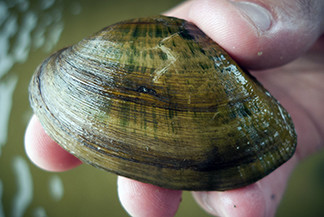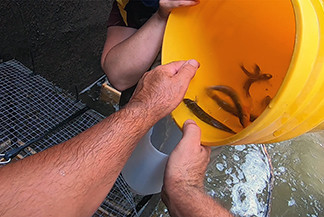Growing nature's clean-water engineers
By SUZANNE STONE and CASEY WARNER
Michigan Department of Natural Resources
Although small, snuffbox mussels carry a lot of weight when it comes to the health of Michigan’s fish and wildlife.
A freshwater mussel that reaches up to 3 inches in length, the snuffbox has been on the federal endangered species list since 2012. They are known to exist in only 79 streams in 14 states and one Canadian province.

“The freshwater mussels of North America have been identified as the most imperiled of any major group of animals. Nearly half of Michigan’s native freshwater mussels are in decline and are listed as endangered, threatened or special concern. The primary causes of decline are habitat loss from dam construction, siltation and impaired water quality,” explains Michigan’s Wildlife Action Plan, a partner-developed, strategic framework for conserving wildlife, especially at-risk species, and their habitats.
The plan identifies snuffbox mussels as a focal species, with a goal of developing and expanding the capacity to rear them in Michigan.
Biologists from the Michigan Department of Natural Resources and Central Michigan University have started working toward that goal with a project to propagate, or rear, snuffbox at Consumers Energy's Webber Dam on the Grand River, near the town of Lyons in Ionia County.
CMU student researchers recently added microscopic larval mussels called glochidia to water with common logperch, a fish that acts as a host for a short period of the snuffbox lifecycle. The tiny mussels attached to the gills of the logperch, which are unharmed by their host duties, and then the fish with the microscopic mussels were transferred to cages in the DNR’s fish ladder at the Webber Dam.
This fish ladder, constructed in the late 1970s and early 1980s as part of a Grand River migratory fish project, allows steelhead and salmon to ascend the river during their spawning runs.
|

The snuffbox mussels, which dropped off the logperch after they matured for a few weeks, will grow for approximately 16 months in the cages there. DNR and CMU biologists then will tag and release the young mussels back into the river at sites between Webber Dam and the confluence of the Maple River to help increase the species’ population.
Watch a video about the snuffbox mussel propagation project.
“This is the first time this propagation system has been used for snuffbox mussels in Michigan,” said Scott Hanshue, a former DNR fisheries management biologist who recently retired. “This project would not be possible without the work being done by CMU, and we can’t thank Consumers Energy enough for their willingness to provide space for us and the project team’s equipment to work on their property, and for changing their operations to provide water where it’s needed, a necessity for this study to be successful.”
Consumers Energy is making sure water flows through the fish ladder to support the project. The energy provider normally diverts water to the fish ladder just twice a year — in the spring and fall — to allow salmon and steelhead to bypass the dam during their migrations.
“It was an easy decision to say ‘yes’ to supporting this project to aid the endangered mussels,” said Neil Dziedzic, Consumers Energy’s executive director of hydro operations. “This work aligns well with our hydro operations which produce clean, renewable energy and with our Triple Bottom Line to benefit People, Planet and Prosperity, which drives all our decisions at Consumers Energy.”
|

In addition to Consumers Energy and CMU, strong partnerships with the U.S. Fish and Wildlife Service and the Ionia Conservation District – which provided funding though the National Fish Passage Program, with the USFWS’ Michigan Field Office approving the project – made these efforts possible.
The snuffbox mussel propagation project location is upstream from where some of the species’ prime habitat was degraded by a covering of sediment, which entered the Grand River following the removal of Lyons Dam. Heavy rains flushed a large amount of soil into the river where erosion-protective vegetation had been stripped during the dam’s removal.
The Grand River, which Hanshue calls “a stronghold for snuffbox,” is one of several Michigan rivers where the species has been identified. The others include the Flat and Maple rivers in the Lake Michigan drainage, the Pine, Belle and Clinton rivers in the Lake St. Clair drainage and the Huron River in the Lake Erie drainage.
The snuffbox is one of 43 species of mussels in Michigan.
Mussels play an important role in aquatic ecosystems, serving as natural filters as they feed on algae, plankton and silts and help purify the water.
“The neat thing about native freshwater mussels is that they’re really efficient filter feeders so they will be filtering contaminants out of the water,” said Daelyn Woolnough, one of the CMU biologists working on the snuffbox propagation project. “They’re taking all those chemicals and keeping them in their bodies, and then when they die, instead of releasing them into the water column like a zebra mussel does when it dies, they’re actually burrowing it into the bottom.”
|

Freshwater mussels are considered aquatic ecosystem “engineers” as they not only filter the water but make food and habitat available to other animals, increasing aquatic species diversity and abundance.
Mussels capture organic matter from the water, processing it to build their body and shell and then excreting nutrients for plants and depositing the remaining organic material to the sediment, making it available for other invertebrates and fish to eat.
Algae and insect larvae also attach to mussels’ shells and, when there are large numbers of mussels, they may become underwater gardens that attract fish to feed.
Mussels are an important food source for many species of wildlife including otters, raccoon, muskrat, herons, egrets and some fish. Their beds – gravel and sand with occasional cobble and boulders – provide habitat for fish, aquatic insects and worms.
They also are good indicators of aquatic health. According to the U.S. Fish and Wildlife Service website, “The presence of diverse and reproducing populations of mussels indicate a healthy aquatic system which means good fishing, good water quality for waterfowl and other wildlife species, as well as insurance that our water is safe.”
The website also discusses the importance of collaboration in helping mussels like the snuffbox recover, saying, “The snuffbox cannot survive without help from watershed partnerships to restore habitat and improve surface lands. … The voluntary assistance of federal and state agencies, conservation groups, local governments, private landowners, industries, businesses and farming communities will be necessary to meet recovery goals.”
The collaborative effort to rear snuffbox mussels offers a good example of the kind of partnership needed to help these little powerhouses recover.
Learn more about how the DNR manages Michigan’s fisheries at Michigan.gov/Fishing.
|
Check out previous Showcasing the DNR stories in our archive at Michigan.gov/DNRStories. To subscribe to upcoming Showcasing articles, sign up for free email delivery at Michigan.gov/DNR.
/Note to editors: Contact: John Pepin, Showcasing the DNR series editor, 906-226-1352. Accompanying photos and a text-only version of this story are available below for download. Caption information follows. Credit Michigan Department of Natural Resources, unless otherwise noted.
Text-only version - Showcasing - snuffbox mussles
Cage: Snuffbox mussels will grow for approximately 16 months in cages at the Department of Natural Resources’ fish ladder at Webber Dam on the Grand River.
Dam: Consumers Energy's Webber Dam on the Grand River, near the town of Lyons in Ionia County, is the site of the project to rear snuffbox mussels.
Ladder: The DNR’s fish ladder at Webber Dam, constructed in the late 70s/early 80s as part of a Grand River migratory fish project, allows steelhead and salmon to ascend the river during their spawning runs.
Logperch and Logperch2: The common logperch is a fish that acts as a host for a short period of the snuffbox lifecycle. Microscopic larval mussels called glochidia attach to the gills of the logperch, which are unharmed by their host duties, and then drop off after they mature for a few weeks.
Mussel and Mussel2: The snuffbox, a small to medium-sized mussel reaching up to 3 inches in length, has been on the federal endangered species list since 2012.
Shells: Snuffbox mussel shells are yellowish-green to brown and adorned with dark green rays or chevron-like marks.
Trailer: Pictured is the Central Michigan University biologists’ research trailer, which housed aquaculture tanks containing logperch with tiny snuffbox mussels on their gills./
|